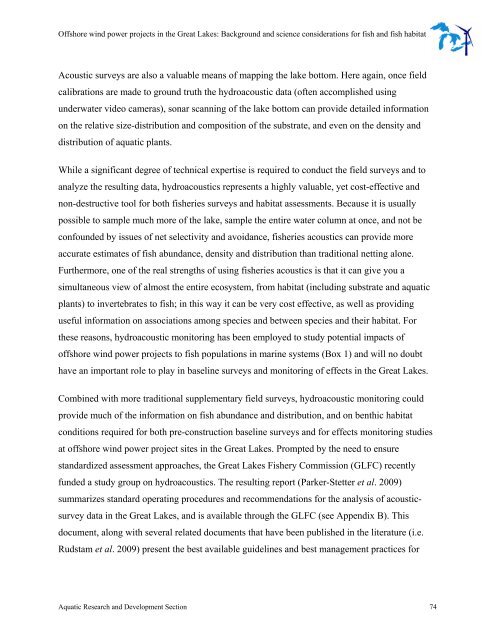Offshore Wind Power Projects in the Great Lakes - Ministry of ...
Offshore Wind Power Projects in the Great Lakes - Ministry of ...
Offshore Wind Power Projects in the Great Lakes - Ministry of ...
Create successful ePaper yourself
Turn your PDF publications into a flip-book with our unique Google optimized e-Paper software.
<strong>Offshore</strong> w<strong>in</strong>d power projects <strong>in</strong> <strong>the</strong> <strong>Great</strong> <strong>Lakes</strong>: Background and science considerations for fish and fish habitat<br />
Acoustic surveys are also a valuable means <strong>of</strong> mapp<strong>in</strong>g <strong>the</strong> lake bottom. Here aga<strong>in</strong>, once field<br />
calibrations are made to ground truth <strong>the</strong> hydroacoustic data (<strong>of</strong>ten accomplished us<strong>in</strong>g<br />
underwater video cameras), sonar scann<strong>in</strong>g <strong>of</strong> <strong>the</strong> lake bottom can provide detailed <strong>in</strong>formation<br />
on <strong>the</strong> relative size-distribution and composition <strong>of</strong> <strong>the</strong> substrate, and even on <strong>the</strong> density and<br />
distribution <strong>of</strong> aquatic plants.<br />
While a significant degree <strong>of</strong> technical expertise is required to conduct <strong>the</strong> field surveys and to<br />
analyze <strong>the</strong> result<strong>in</strong>g data, hydroacoustics represents a highly valuable, yet cost-effective and<br />
non-destructive tool for both fisheries surveys and habitat assessments. Because it is usually<br />
possible to sample much more <strong>of</strong> <strong>the</strong> lake, sample <strong>the</strong> entire water column at once, and not be<br />
confounded by issues <strong>of</strong> net selectivity and avoidance, fisheries acoustics can provide more<br />
accurate estimates <strong>of</strong> fish abundance, density and distribution than traditional nett<strong>in</strong>g alone.<br />
Fur<strong>the</strong>rmore, one <strong>of</strong> <strong>the</strong> real strengths <strong>of</strong> us<strong>in</strong>g fisheries acoustics is that it can give you a<br />
simultaneous view <strong>of</strong> almost <strong>the</strong> entire ecosystem, from habitat (<strong>in</strong>clud<strong>in</strong>g substrate and aquatic<br />
plants) to <strong>in</strong>vertebrates to fish; <strong>in</strong> this way it can be very cost effective, as well as provid<strong>in</strong>g<br />
useful <strong>in</strong>formation on associations among species and between species and <strong>the</strong>ir habitat. For<br />
<strong>the</strong>se reasons, hydroacoustic monitor<strong>in</strong>g has been employed to study potential impacts <strong>of</strong><br />
<strong>of</strong>fshore w<strong>in</strong>d power projects to fish populations <strong>in</strong> mar<strong>in</strong>e systems (Box 1) and will no doubt<br />
have an important role to play <strong>in</strong> basel<strong>in</strong>e surveys and monitor<strong>in</strong>g <strong>of</strong> effects <strong>in</strong> <strong>the</strong> <strong>Great</strong> <strong>Lakes</strong>.<br />
Comb<strong>in</strong>ed with more traditional supplementary field surveys, hydroacoustic monitor<strong>in</strong>g could<br />
provide much <strong>of</strong> <strong>the</strong> <strong>in</strong>formation on fish abundance and distribution, and on benthic habitat<br />
conditions required for both pre-construction basel<strong>in</strong>e surveys and for effects monitor<strong>in</strong>g studies<br />
at <strong>of</strong>fshore w<strong>in</strong>d power project sites <strong>in</strong> <strong>the</strong> <strong>Great</strong> <strong>Lakes</strong>. Prompted by <strong>the</strong> need to ensure<br />
standardized assessment approaches, <strong>the</strong> <strong>Great</strong> <strong>Lakes</strong> Fishery Commission (GLFC) recently<br />
funded a study group on hydroacoustics. The result<strong>in</strong>g report (Parker-Stetter et al. 2009)<br />
summarizes standard operat<strong>in</strong>g procedures and recommendations for <strong>the</strong> analysis <strong>of</strong> acousticsurvey<br />
data <strong>in</strong> <strong>the</strong> <strong>Great</strong> <strong>Lakes</strong>, and is available through <strong>the</strong> GLFC (see Appendix B). This<br />
document, along with several related documents that have been published <strong>in</strong> <strong>the</strong> literature (i.e.<br />
Rudstam et al. 2009) present <strong>the</strong> best available guidel<strong>in</strong>es and best management practices for<br />
Aquatic Research and Development Section 74
















